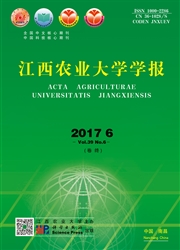

 中文摘要:
中文摘要:
为了研究离子液体对微藻生长及生理特性的影响,以聚球藻7942(Synechococcus sp.PCC 7942)为实验材料,分析1-辛基-3-甲基咪唑溴盐(1-octyl-3-methylimidazolium bromide;[C8mim] Br)对其生长及生理特性的影响.结果表明:(1)[C8mim] Br严重抑制聚球藻的生长,这种抑制作用可能是由藻细胞膜被破坏引起的.(2)低浓度[C8mim] Br可诱导藻细胞合成超氧化物歧化酶(Superoxide dismutase,SOD)等可溶性蛋白,抵御[C8mim] Br的胁迫;但高浓度[C8mim] Br又会使SOD等酶活力降低.(3)随着[C8 mim] Br浓度的升高,藻细胞中丙二醛(Malondialdehyde,MDA)含量显著增加,表明细胞中活性氧自由基(Reactive oxygen species,ROS)过量积累,这将破坏聚球藻的细胞膜结构与功能,使细胞遭受严重损伤.因此,[C8mim] Br可通过破坏藻细胞膜的结构与功能,导致细胞变形、分裂,从而影响藻细胞的生长繁殖,这将为探讨[C8 mim] Br的毒性效应机制及其环境风险评价提供数据资料和科学依据.
 英文摘要:
英文摘要:
The growth and physiological characteristics of Synechococcus sp. PCC 7942 under different 1 - octyl- 3 -methylimidazolium bromide ([ C8mim] Br) concentrations were analyzed to exploit the effects of i- onic liquids on microalgae. The results showed that [ C8mim ] Br had a significant inhibition effect on the growth of Synechococcus sp. PCC 7942 ,which may be due to the destruction of microalgal cell membrane. Low concen- trations of [ C8mim] Br would induce the synthesis of soluble protein, such as superoxide dismutase (SOD), which played an important role in the defense mechanism to protect cells from [ C8miml Br stresses;but high concentrations of [ C8mim] Br would cause the inactivation of SOD and decrease the protein contents. Moreo- ver,malondialdehyde (MDA) contents in Synechococcus sp. PCC 7942 were enhanced with the increase of[ C8 mim ] Br concentrations, showing that excessive accumulation of reactive oxygen species (ROS) damaged the structure and function of microalgal cell membrane. Therefore, under the stress of [ C8 mim ] Br, the structure and function of the microalgal cell membrane would be damaged by excessive ROS and [ C8mim] Br,which would lead to the inhibition of the microalgal growth. The results provide data for exploiting toxic mechanisms and evaluating environmental impacts of [ C8mim ] Br.
 同期刊论文项目
同期刊论文项目
 同项目期刊论文
同项目期刊论文
 Effects of 1-octyl-3-methylimidazolium bromide on the growth, photosyntheticactivity and antioxidant
Effects of 1-octyl-3-methylimidazolium bromide on the growth, photosyntheticactivity and antioxidant Physiological and biochemical responses of Synechococcus sp. PCC7942 to the stress of barium, chromi
Physiological and biochemical responses of Synechococcus sp. PCC7942 to the stress of barium, chromi 期刊信息
期刊信息
